跨平台原生模块 (C++)
用 C++ 编写模块是在 Android 和 iOS 之间共享平台无关代码的最佳方式。使用纯 C++ 模块,您只需编写一次逻辑,即可从所有平台立即重用,而无需编写特定于平台的代码。
本指南将引导您完成纯 C++ Turbo Native 模块的创建
- 创建 JS 规范
- 配置 Codegen 以生成脚手架
- 实现原生逻辑
- 在 Android 和 iOS 应用程序中注册模块
- 在 JS 中测试您的更改
本指南的其余部分假设您已通过运行以下命令创建了应用程序
npx @react-native-community/cli@latest init SampleApp --version 0.80.0
1. 创建 JS 规范
纯 C++ Turbo Native 模块是 Turbo Native 模块。它们需要一个规范文件(也称为 spec 文件),以便 Codegen 可以为我们创建脚手架代码。规范文件也是我们用来在 JS 中访问 Turbo Native 模块的。
规范文件需要用类型化的 JS 方言编写。React Native 目前支持 Flow 或 TypeScript。
- 在应用程序的根文件夹中,创建一个名为
specs的新文件夹。 - 创建一个名为
NativeSampleModule.ts的新文件,其中包含以下代码
所有原生 Turbo 模块规范文件必须以 Native 为前缀,否则 Codegen 将忽略它们。
- TypeScript
- Flow
// @flow
import type {TurboModule} from 'react-native'
import { TurboModuleRegistry } from "react-native";
export interface Spec extends TurboModule {
+reverseString: (input: string) => string;
}
export default (TurboModuleRegistry.getEnforcing<Spec>(
"NativeSampleModule"
): Spec);
import {TurboModule, TurboModuleRegistry} from 'react-native';
export interface Spec extends TurboModule {
readonly reverseString: (input: string) => string;
}
export default TurboModuleRegistry.getEnforcing<Spec>(
'NativeSampleModule',
);
2. 配置 Codegen
下一步是在 package.json 中配置 Codegen。更新文件以包含
"start": "react-native start",
"test": "jest"
},
"codegenConfig": {
"name": "AppSpecs",
"type": "modules",
"jsSrcsDir": "specs",
"android": {
"javaPackageName": "com.sampleapp.specs"
}
},
"dependencies": {
此配置告诉 Codegen 在 specs 文件夹中查找规范文件。它还指示 Codegen 仅为 modules 生成代码,并将生成的代码命名为 AppSpecs。
3. 编写原生代码
编写 C++ Turbo Native 模块允许您在 Android 和 iOS 之间共享代码。因此,我们将一次性编写代码,并研究需要对平台进行哪些更改才能使其识别 C++ 代码。
-
在
android和ios文件夹的同一级别创建一个名为shared的文件夹。 -
在
shared文件夹中,创建一个名为NativeSampleModule.h的新文件。shared/NativeSampleModule.h#pragma once
#include <AppSpecsJSI.h>
#include <memory>
#include <string>
namespace facebook::react {
class NativeSampleModule : public NativeSampleModuleCxxSpec<NativeSampleModule> {
public:
NativeSampleModule(std::shared_ptr<CallInvoker> jsInvoker);
std::string reverseString(jsi::Runtime& rt, std::string input);
};
} // namespace facebook::react -
在
shared文件夹中,创建一个名为NativeSampleModule.cpp的新文件。shared/NativeSampleModule.cpp#include "NativeSampleModule.h"
namespace facebook::react {
NativeSampleModule::NativeSampleModule(std::shared_ptr<CallInvoker> jsInvoker)
: NativeSampleModuleCxxSpec(std::move(jsInvoker)) {}
std::string NativeSampleModule::reverseString(jsi::Runtime& rt, std::string input) {
return std::string(input.rbegin(), input.rend());
}
} // namespace facebook::react
让我们看看我们创建的两个文件
NativeSampleModule.h文件是纯 C++ TurboModule 的头文件。include语句确保我们包含将由 Codegen 创建的规范,这些规范包含我们需要实现的接口和基类。- 模块位于
facebook::react命名空间中,以便访问该命名空间中的所有类型。 - 类
NativeSampleModule是实际的 Turbo Native 模块类,它扩展了NativeSampleModuleCxxSpec类,该类包含一些粘合代码和样板代码,使该类能够作为 Turbo Native 模块。 - 最后,我们有构造函数,它接受指向
CallInvoker的指针,以便在需要时与 JS 通信,以及我们必须实现的函数原型。
NativeSampleModule.cpp 文件是我们 Turbo Native 模块的实际实现,它实现了我们在规范中声明的构造函数和方法。
4. 在平台中注册模块
接下来的步骤将让我们在平台中注册模块。这是将原生代码暴露给 JS 的步骤,以便 React Native 应用程序最终可以从 JS 层调用原生方法。
这是我们唯一需要编写一些特定于平台代码的时候。
Android
为了确保 Android 应用程序能够有效地构建 C++ Turbo Native 模块,我们需要
- 创建一个
CMakeLists.txt来访问我们的 C++ 代码。 - 修改
build.gradle以指向新创建的CMakeLists.txt文件。 - 在我们的 Android 应用程序中创建一个
OnLoad.cpp文件来注册新的 Turbo Native 模块。
1. 创建 CMakeLists.txt 文件
Android 使用 CMake 进行构建。CMake 需要访问我们在共享文件夹中定义的文件才能构建它们。
- 创建一个新文件夹
SampleApp/android/app/src/main/jni。jni文件夹是 Android 的 C++ 端所在的位置。 - 创建一个
CMakeLists.txt文件并添加此上下文
cmake_minimum_required(VERSION 3.13)
# Define the library name here.
project(appmodules)
# This file includes all the necessary to let you build your React Native application
include(${REACT_ANDROID_DIR}/cmake-utils/ReactNative-application.cmake)
# Define where the additional source code lives. We need to crawl back the jni, main, src, app, android folders
target_sources(${CMAKE_PROJECT_NAME} PRIVATE ../../../../../shared/NativeSampleModule.cpp)
# Define where CMake can find the additional header files. We need to crawl back the jni, main, src, app, android folders
target_include_directories(${CMAKE_PROJECT_NAME} PUBLIC ../../../../../shared)
CMake 文件执行以下操作
- 定义
appmodules库,其中将包含所有应用程序 C++ 代码。 - 加载基础 React Native 的 CMake 文件。
- 使用
target_sources指令添加我们需要构建的模块 C++ 源代码。默认情况下,React Native 将已经用默认源填充appmodules库,这里我们包含我们自定义的。您可以看到我们需要从jni文件夹爬回到shared文件夹,我们的 C++ Turbo 模块就位于该文件夹中。 - 指定 CMake 可以在哪里找到模块头文件。同样在这种情况下,我们需要从
jni文件夹爬回。
2. 修改 build.gradle 以包含自定义 C++ 代码
Gradle 是协调 Android 构建的工具。我们需要告诉它在哪里可以找到 CMake 文件来构建 Turbo Native 模块。
- 打开
SampleApp/android/app/build.gradle文件。 - 在 Gradle 文件中,在现有的
android块内添加以下块
buildTypes {
debug {
signingConfig signingConfigs.debug
}
release {
// Caution! In production, you need to generate your own keystore file.
// see https://reactnative.net.cn/docs/signed-apk-android.
signingConfig signingConfigs.debug
minifyEnabled enableProguardInReleaseBuilds
proguardFiles getDefaultProguardFile("proguard-android.txt"), "proguard-rules.pro"
}
}
+ externalNativeBuild {
+ cmake {
+ path "src/main/jni/CMakeLists.txt"
+ }
+ }
}
此块告诉 Gradle 文件在哪里查找 CMake 文件。路径是相对于 build.gradle 文件所在的文件夹的,因此我们需要添加 jni 文件夹中 CMakeLists.txt 文件的路径。
3. 注册新的 Turbo Native 模块
最后一步是在运行时注册新的 C++ Turbo Native 模块,以便当 JS 需要 C++ Turbo Native 模块时,应用程序知道在哪里可以找到它并可以返回它。
- 从文件夹
SampleApp/android/app/src/main/jni,运行以下命令
curl -O https://raw.githubusercontent.com/facebook/react-native/v0.76.0/packages/react-native/ReactAndroid/cmake-utils/default-app-setup/OnLoad.cpp
- 然后,按如下方式修改此文件
#include <DefaultComponentsRegistry.h>
#include <DefaultTurboModuleManagerDelegate.h>
#include <autolinking.h>
#include <fbjni/fbjni.h>
#include <react/renderer/componentregistry/ComponentDescriptorProviderRegistry.h>
#include <rncore.h>
+ // Include the NativeSampleModule header
+ #include <NativeSampleModule.h>
//...
std::shared_ptr<TurboModule> cxxModuleProvider(
const std::string& name,
const std::shared_ptr<CallInvoker>& jsInvoker) {
// Here you can provide your CXX Turbo Modules coming from
// either your application or from external libraries. The approach to follow
// is similar to the following (for a module called `NativeCxxModuleExample`):
//
// if (name == NativeCxxModuleExample::kModuleName) {
// return std::make_shared<NativeCxxModuleExample>(jsInvoker);
// }
+ // This code register the module so that when the JS side asks for it, the app can return it
+ if (name == NativeSampleModule::kModuleName) {
+ return std::make_shared<NativeSampleModule>(jsInvoker);
+ }
// And we fallback to the CXX module providers autolinked
return autolinking_cxxModuleProvider(name, jsInvoker);
}
// leave the rest of the file
这些步骤从 React Native 下载原始的 OnLoad.cpp 文件,以便我们可以安全地覆盖它以在应用程序中加载 C++ Turbo Native 模块。
一旦我们下载了文件,我们可以通过以下方式修改它
- 包含指向我们模块的头文件
- 注册 Turbo Native 模块,以便当 JS 需要它时,应用程序可以返回它。
现在,您可以从项目根目录运行 yarn android 来查看您的应用程序成功构建。
iOS
为了确保 iOS 应用程序能够有效地构建 C++ Turbo Native 模块,我们需要
- 安装 Pods 并运行 Codegen。
- 将
shared文件夹添加到我们的 iOS 项目中。 - 在应用程序中注册 C++ Turbo Native 模块。
1. 安装 Pods 并运行 Codegen。
我们需要运行的第一步是我们每次准备 iOS 应用程序时运行的常规步骤。CocoaPods 是我们用来设置和安装 React Native 依赖项的工具,作为过程的一部分,它也将为我们运行 Codegen。
cd ios
bundle install
bundle exec pod install
2. 将共享文件夹添加到 iOS 项目
此步骤将 shared 文件夹添加到项目中,使其对 Xcode 可见。
- 打开 CocoaPods 生成的 Xcode 工作区。
cd ios
open SampleApp.xcworkspace
- 点击左侧的
SampleApp项目,然后选择Add files to "Sample App"...。
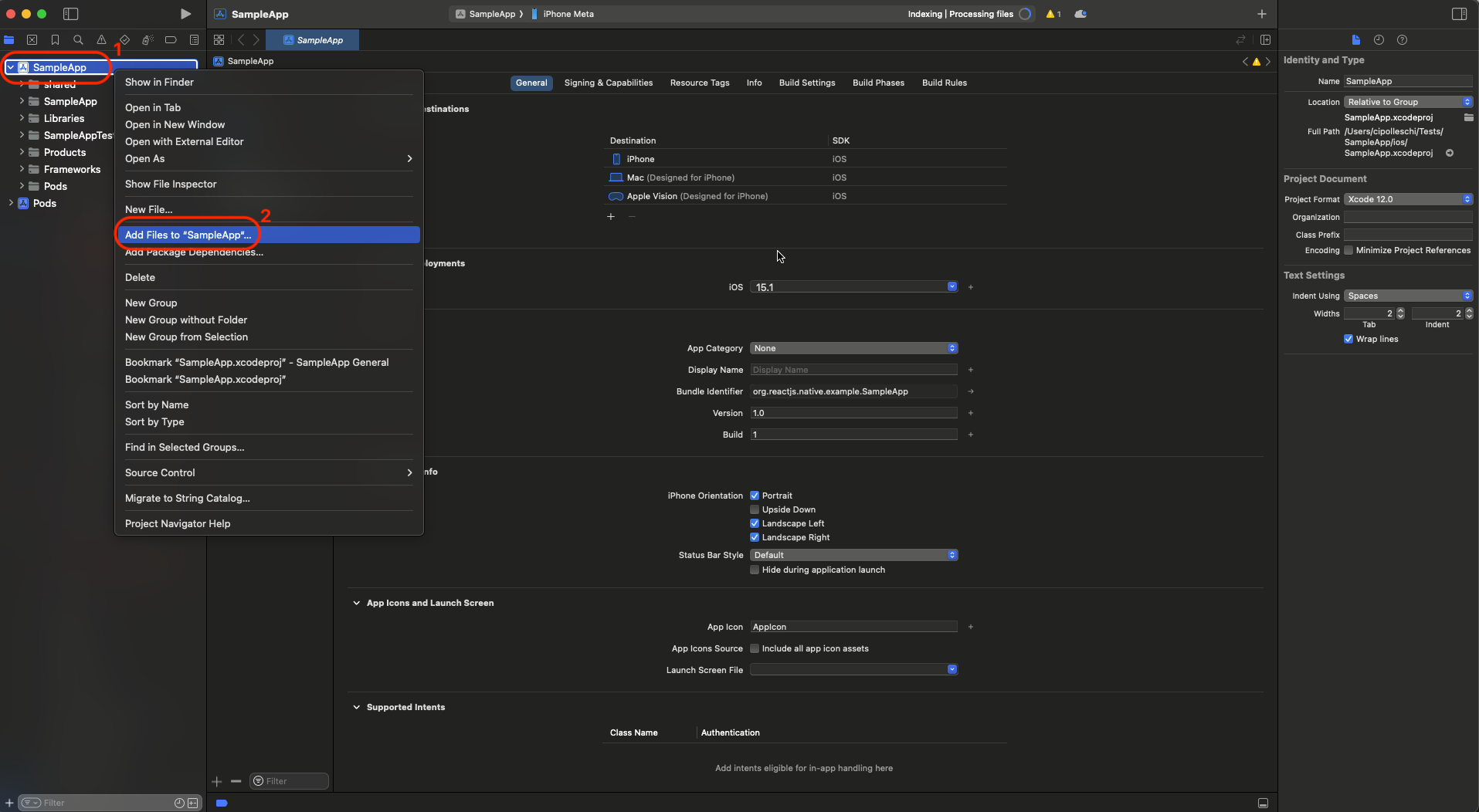
- 选择
shared文件夹,然后点击Add。
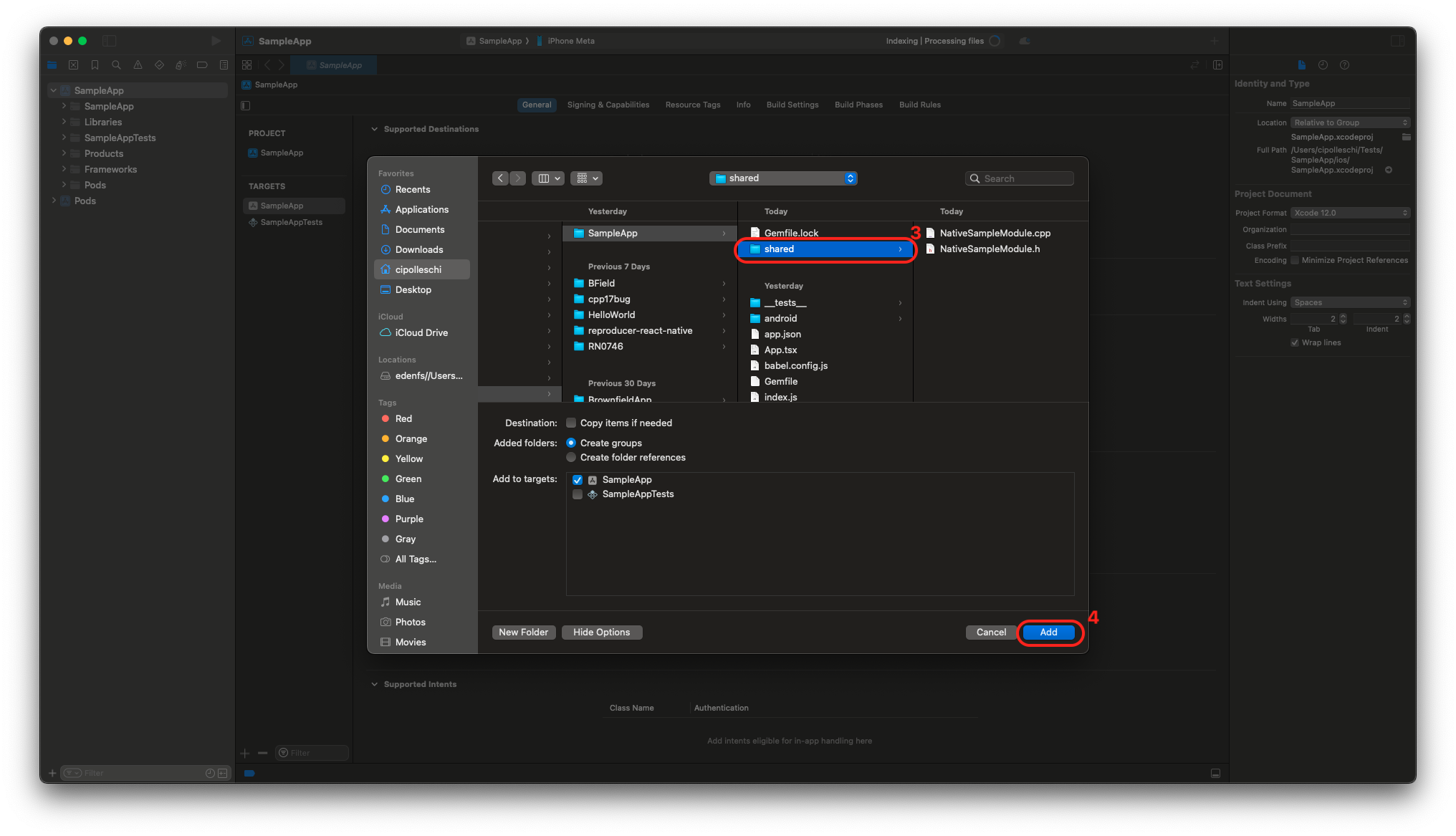
如果一切正确,您左侧的项目应该如下所示
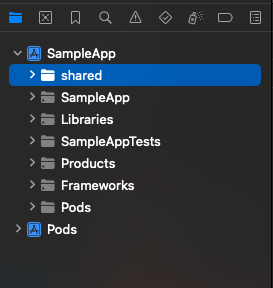
3. 在您的应用程序中注册 Cxx Turbo Native 模块
要在您的应用程序中注册纯 Cxx Turbo Native 模块,您需要
- 为原生模块创建
ModuleProvider - 配置
package.json以将 JS 模块名称与 ModuleProvider 类相关联。
ModuleProvider 是一个 Objective-C++,它将纯 C++ 模块与您的 iOS 应用程序的其余部分粘合在一起。
3.1 创建 ModuleProvider
- 在 Xcode 中,选择
SampleApp项目,然后按 ⌘ + N 创建一个新文件。 - 选择
Cocoa Touch Class模板 - 添加名称
SampleNativeModuleProvider(将其他字段保留为Subclass of: NSObject和Language: Objective-C) - 点击 Next 生成文件。
- 将
SampleNativeModuleProvider.m重命名为SampleNativeModuleProvider.mm。mm扩展名表示一个 Objective-C++ 文件。 - 用以下内容实现
SampleNativeModuleProvider.h的内容
#import <Foundation/Foundation.h>
#import <ReactCommon/RCTTurboModule.h>
NS_ASSUME_NONNULL_BEGIN
@interface NativeSampleModuleProvider : NSObject <RCTModuleProvider>
@end
NS_ASSUME_NONNULL_END
这声明了一个符合 RCTModuleProvider 协议的 NativeSampleModuleProvider 对象。
- 用以下内容实现
SampleNativeModuleProvider.mm的内容
#import "NativeSampleModuleProvider.h"
#import <ReactCommon/CallInvoker.h>
#import <ReactCommon/TurboModule.h>
#import "NativeSampleModule.h"
@implementation NativeSampleModuleProvider
- (std::shared_ptr<facebook::react::TurboModule>)getTurboModule:
(const facebook::react::ObjCTurboModule::InitParams &)params
{
return std::make_shared<facebook::react::NativeSampleModule>(params.jsInvoker);
}
@end
此代码通过在调用 getTurboModule: 方法时创建纯 C++ NativeSampleModule 来实现 RCTModuleProvider 协议。
3.2 更新 package.json
最后一步是更新 package.json,以告诉 React Native 原生模块的 JS 规范与这些规范在原生代码中的具体实现之间的链接。
按如下方式修改 package.json
"start": "react-native start",
"test": "jest"
},
"codegenConfig": {
"name": "AppSpecs",
"type": "modules",
"jsSrcsDir": "specs",
"android": {
"javaPackageName": "com.sampleapp.specs"
},
"ios": {
"modulesProvider": {
"NativeSampleModule": "NativeSampleModuleProvider"
}
}
},
"dependencies": {
此时,您需要重新安装 Pods,以确保 Codegen 再次运行以生成新文件
# from the ios folder
bundle exec pod install
open SampleApp.xcworkspace
如果您现在从 Xcode 构建您的应用程序,您应该能够成功构建。
5. 测试您的代码
现在是时候从 JS 访问我们的 C++ Turbo Native 模块了。为此,我们必须修改 App.tsx 文件以导入 Turbo Native 模块并在我们的代码中调用它。
- 打开
App.tsx文件。 - 用以下代码替换模板的内容
import React from 'react';
import {
Button,
SafeAreaView,
StyleSheet,
Text,
TextInput,
View,
} from 'react-native';
import SampleTurboModule from './specs/NativeSampleModule';
function App(): React.JSX.Element {
const [value, setValue] = React.useState('');
const [reversedValue, setReversedValue] = React.useState('');
const onPress = () => {
const revString = SampleTurboModule.reverseString(value);
setReversedValue(revString);
};
return (
<SafeAreaView style={styles.container}>
<View>
<Text style={styles.title}>
Welcome to C++ Turbo Native Module Example
</Text>
<Text>Write down here he text you want to revert</Text>
<TextInput
style={styles.textInput}
placeholder="Write your text here"
onChangeText={setValue}
value={value}
/>
<Button title="Reverse" onPress={onPress} />
<Text>Reversed text: {reversedValue}</Text>
</View>
</SafeAreaView>
);
}
const styles = StyleSheet.create({
container: {
flex: 1,
justifyContent: 'center',
alignItems: 'center',
},
title: {
fontSize: 18,
marginBottom: 20,
},
textInput: {
borderColor: 'black',
borderWidth: 1,
borderRadius: 5,
padding: 10,
marginTop: 10,
},
});
export default App;
此应用程序中有趣的行是
import SampleTurboModule from './specs/NativeSampleModule';:此行在应用程序中导入 Turbo Native 模块,const revString = SampleTurboModule.reverseString(value);在onPress回调中:这是您在应用程序中使用 Turbo Native 模块的方式。
为了本示例的缘故并使其尽可能简短,我们直接在应用程序中导入了规范文件。在这种情况下,最佳实践是创建一个单独的文件来包装规范,并在您的应用程序中使用该文件。这允许您为规范准备输入,并让您在 JS 中对它们有更多的控制。
恭喜,您编写了您的第一个 C++ Turbo Native 模块!
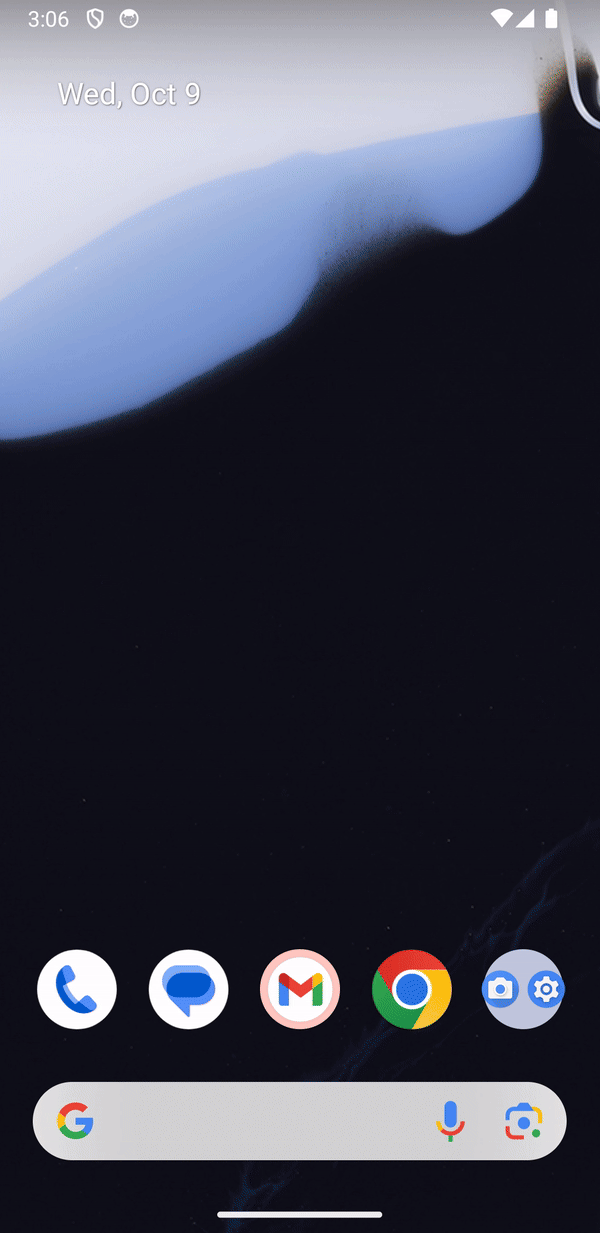 | 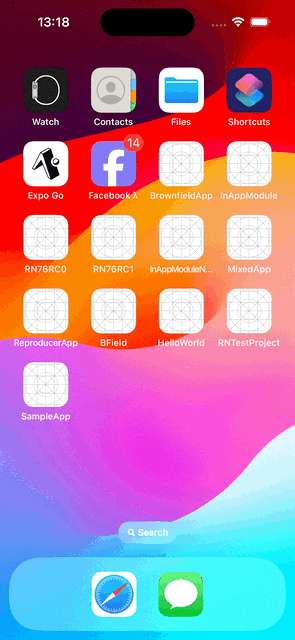 |